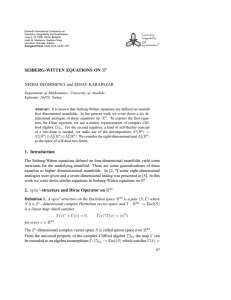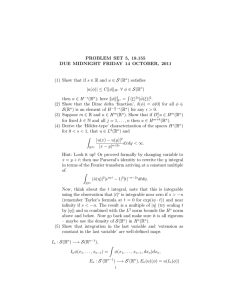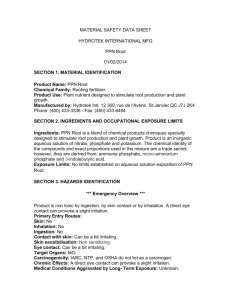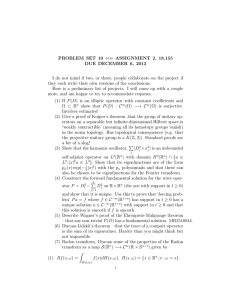Electronic Journal of Differential Equations, Vol. 2016 (2016), No. 09,... ISSN: 1072-6691. URL: or
advertisement
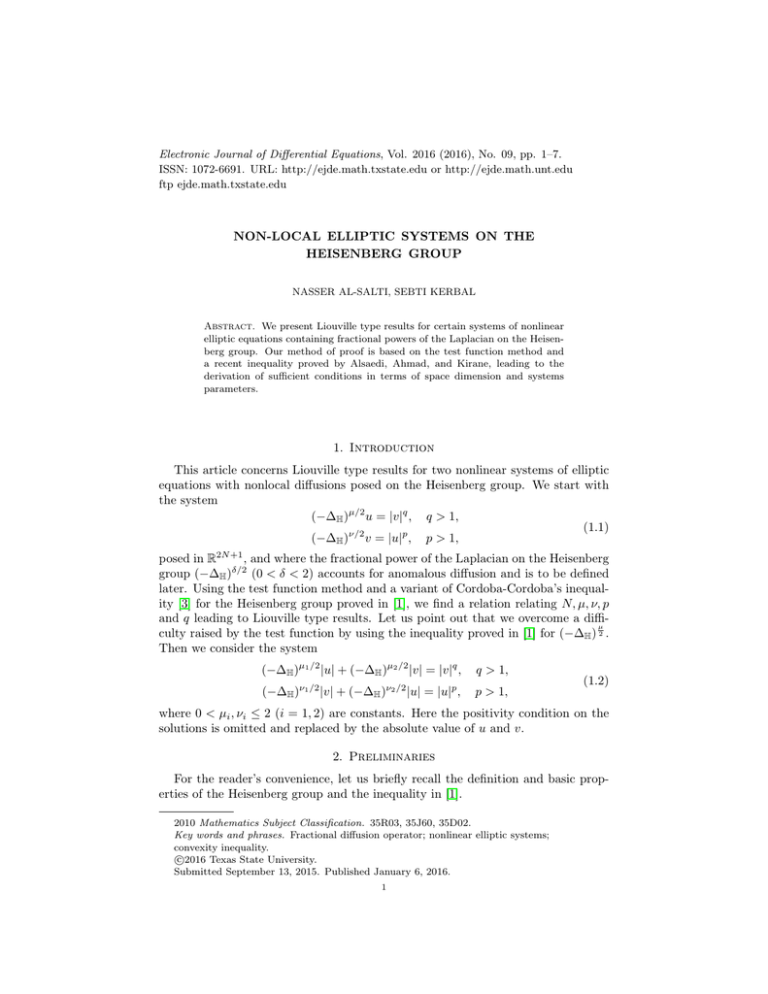
Electronic Journal of Differential Equations, Vol. 2016 (2016), No. 09, pp. 1–7.
ISSN: 1072-6691. URL: http://ejde.math.txstate.edu or http://ejde.math.unt.edu
ftp ejde.math.txstate.edu
NON-LOCAL ELLIPTIC SYSTEMS ON THE
HEISENBERG GROUP
NASSER AL-SALTI, SEBTI KERBAL
Abstract. We present Liouville type results for certain systems of nonlinear
elliptic equations containing fractional powers of the Laplacian on the Heisenberg group. Our method of proof is based on the test function method and
a recent inequality proved by Alsaedi, Ahmad, and Kirane, leading to the
derivation of sufficient conditions in terms of space dimension and systems
parameters.
1. Introduction
This article concerns Liouville type results for two nonlinear systems of elliptic
equations with nonlocal diffusions posed on the Heisenberg group. We start with
the system
(−∆H )µ/2 u = |v|q , q > 1,
(1.1)
(−∆H )ν/2 v = |u|p , p > 1,
posed in R2N +1 , and where the fractional power of the Laplacian on the Heisenberg
group (−∆H )δ/2 (0 < δ < 2) accounts for anomalous diffusion and is to be defined
later. Using the test function method and a variant of Cordoba-Cordoba’s inequality [3] for the Heisenberg group proved in [1], we find a relation relating N, µ, ν, p
and q leading to Liouville type results. Let us point out that we overcome a diffiµ
culty raised by the test function by using the inequality proved in [1] for (−∆H ) 2 .
Then we consider the system
(−∆H )µ1 /2 |u| + (−∆H )µ2 /2 |v| = |v|q ,
(−∆H )
ν1 /2
ν2 /2
|v| + (−∆H )
p
|u| = |u| ,
q > 1,
p > 1,
(1.2)
where 0 < µi , νi ≤ 2 (i = 1, 2) are constants. Here the positivity condition on the
solutions is omitted and replaced by the absolute value of u and v.
2. Preliminaries
For the reader’s convenience, let us briefly recall the definition and basic properties of the Heisenberg group and the inequality in [1].
2010 Mathematics Subject Classification. 35R03, 35J60, 35D02.
Key words and phrases. Fractional diffusion operator; nonlinear elliptic systems;
convexity inequality.
c
2016
Texas State University.
Submitted September 13, 2015. Published January 6, 2016.
1
2
N. AL-SALTI, S. KERBAL
EJDE-2016/09
2.1. Heisenberg group. The Heisenberg group H, whose points will be denoted
by η = (x, y, τ ), is the Lie group (R2N +1 , ◦) with the non-commutative group
operation ◦ defined by
η ◦ η̃ = (x + x̃, y + ỹ, τ + τ̃ + 2(x · ỹ − x̃ · y)),
where “·” is the usual inner product in RN . The Laplacian ∆H over H is obtained
∂
∂
∂
∂
+ 2yi ∂τ
− 2xi ∂τ
from the vector fields Xi = ∂x
and Yi = ∂y
, by
i
i
∆H =
N
X
(Xi2 + Yi2 ).
(2.1)
i=1
Explicit computation gives the expression
N 2
X
∂2
∂2
∂2
∂2 ∂
+ 2 + 4yi
− 4xi
+ 4(x2i + yi2 ) 2 .
∆H =
2
∂xi
∂yi
∂xi ∂τ
∂yi ∂τ
∂τ
i=1
(2.2)
A natural group of dilations on H is given by
δλ (η) = (λx, λy, λ2 τ ),
λ > 0,
Q
whose Jacobian determinant is λ , where
Q = 2N + 2
(2.3)
is the homogeneous dimension of H.
The operator ∆H is a degenerate elliptic operator. It is invariant with respect to
the left translation of H and homogeneous with respect to the dilations δλ . More
precisely, we have
∆H (u(η ◦ η̃)) = (∆H u)(η ◦ η̃),
(2.4)
∆H (u ◦ δλ ) = λ2 (∆H u) ◦ δλ , η, η̃ ∈ H.
The natural distance from η to the origin is
N
X
2 1/4
|η|H = τ 2 +
(x2i + yi2 )
.
(2.5)
i=1
2.2. Fractional powers of sub-elliptic Laplacians. The representation of the
fractional power of (−∆H )s is given by the following theorem.
Theorem 2.1. The operator ∆H is a positive self-adjoint operator with domain
WH2,2 (H). Denote now by {E(λ)} the spectral resolution of ∆H in L2 (H). If α > 0,
then
Z +∞
(−∆H )α/2 =
λα/2 dE(λ),
0
with domain
WHα,2 (H) := {v ∈ L2 (H);
Z
+∞
λα dhE(λ)v, vi < ∞},
0
endowed with graph norm.
Proposition 2.2 ([1]). Assume that the function ϕ ∈ C0∞ (R2N +1 ). Then
σϕσ−1 (−∆H )σ/2 ϕ ≥ (−∆H )σ/2 ϕσ
holds point-wise.
A proof of the above proposition can be found in [1].
(2.6)
EJDE-2016/09
NON-LOCAL ELLIPTIC SYSTEMS
3
3. Main results
The definition of solutions we adopt for system (1.1) is as follows.
Definition 3.1. We say that the pair (u, v) is a weak solution of (1.1), if
(u, v) ∈ Lploc (R2N +1 ) × Lqloc (R2N +1 ),
Z
µ/2
u(−∆) ψ dx =
|v|q ψ dx,
R2N +1
R2N +1
Z
Z
v(−∆)ν/2 ψ dx =
|u|p ψ dx,
Z
R2N +1
(3.1)
(3.2)
R2N +1
for any nonnegative test function ψ ∈ C0∞ (R2N +1 ).
Before we present our results, let us mention some important works on Liouville
type theorems for the classical nonlinear elliptic equations/systems on the Heisenberg group. Véron and Pohozaev [9] improved the study of Birindelli, Capuzzo
Dolcetta and Cutri [2] concerning the equation
∆H (au) + |u|p ≤ 0
(3.3)
with a bounded function a and 1 < p; they proved that (3.3) admits only trivial
Q
. Their work has been improved recently by Xu [10]
solution whenever 1 < p ≤ Q−2
who proved that u ≡ 0 provided 1 < p < Q(Q+2)
(Q−1)2 .
For nonlinear equations we refer to the paper of Garofalo and Lanconelli [5]
as well as the one of Uguzzoni [8]. Recently, Quas and Xi [7] emphasis that, the
condition 1 < p, q ≤ NN−α covered by Dahmani-Karami-Kerbal [4, theorem 2] was
not considered in [7, Theorem 1.3]. Here, we are considering the first system 1.1
for fractional Laplacian operators on Heisenberg Group, while in [7] and [4] the
authors treated the system in RN for classical Laplacian with the same fractional
exponents and classical Laplacian with different fractional exponents respectively.
The main result for system (1.1) is as follows.
Theorem 3.2. Let (u, v) be a weak solution of system (1.1). If Q, the homogeneous
dimension of H, satisfies the inequality
ν
pq µ
Q<
max
+ µ, + ν ,
(3.4)
pq − 1
p
q
then (u, v) is trivial.
Our second main results concerns system (1.2).
Theorem 3.3. Let (u, v) be a weak solution to system (1.2). If
Q < max γ, θ
where
n ν p
2
, ν1 +
p−1
n µ q
2
θ = min
, µ1 +
q−1
γ = min
then (u, v) is trivial.
µ2
µ1
pq o
,(
+ ν1 )
,
q−1 q
pq − 1
ν2
ν1
pq o
, ( + µ1 )
,
p−1 p
pq − 1
(3.5)
4
N. AL-SALTI, S. KERBAL
EJDE-2016/09
4. Proofs of main results
0
Note that for a function ψ ∈ C0∞ (RN ), δ ∈ (0, 2] and β > p0 ((β − 1)p0 − β pp > 0)
we have
Z
Z
0
p0
0
0
(β−1)p0 −β pp
δ/2 p0
ψ
|(−∆H ) ψ| dη =
ψ (β−1)p −β p |(−∆H )δ/2 ψ|p dη < ∞,
R2N +1
K
where K := supp(ψ) stands for support of ψ, and p + p0 = pp0 . For the proof of
our main results, we consider a cut-off function ϕ ∈ C0∞ (R) such that 0 ≤ ϕ ≤ 1,
|ϕ0 (r)| ≤ Cr , and for any r > 0,
(
1 if r ≤ 1,
ϕ(r) =
0 if r ≥ 2.
Proof of Theorem 3.2. From (3.1) and (3.2) we have
Z
Z
µ/2 β
u(−∆H ) ψ dη =
|v|q ψ β dη,
R2N +1
R2N +1
Z
Z
ν/2 β
v(−∆H ) ψ dη =
|u|p ψ β dη,
R2N +1
R2N +1
for any nonnegative test function ψ β ∈ C0∞ (RN ) with β > max (p0 , q 0 ).
Using the convexity inequality in Proposition 2.2 and the Hölder inequality, we
estimate the first integral over K as follows,
Z
u(−∆H )µ/2 ψ β dη
2N
+1
R
Z
≤β
uψ β/p ψ −β/p ψ β−1 (−∆H )µ/2 ψ dη
K
1/p Z
Z
1/p0
p0
0
0
p β
ψ (β−1)p −β p |(−∆H )µ/2 ψ|p dη
|u| ψ dη
≤β
,
K
K
0
where K := supp(ψ) and p + p = pp0 .
Similarly, we obtain the estimate for the second integral
Z
v(−∆H )ν/2 ψ β dη
2N
+1
R
Z
≤β
vψ β/q ψ −β/q ψ β−1 (−∆H )ν/2 ψ dη
K
1/q0
Z
1/q Z
q0
0
0
,
≤β
|v|q ψ β dη
ψ (β−1)q −β q |(−∆H )ν/2 ψ|q dη
K
0
K
0
where q + q = qq . If we set
Z
1/r0
0
0
r0
A(r, δ) :=
ψ (β−1)r −β r |(−∆H )δ/2 ψ|r dη
,
K
then we can write
Z
p
β
|u| ψ dη ≤ βA(q, ν)
ZR
2N +1
R2N +1
Z
|v|q ψ β dη
1/q
|u|p ψ β dη
1/p
,
(4.1)
.
(4.2)
2N +1
|v|q ψ β dη ≤ βA(p, µ)
R
Z
R2N +1
EJDE-2016/09
Therefore,
Z
NON-LOCAL ELLIPTIC SYSTEMS
q
β
|v| ψ dη
1/q
≤β
1/q
Z
|u|p ψ β dη
1/pq 5
1/q
A(p, µ)
.
(4.3)
R2N +1
R2N +1
Using (4.1) and (4.3), we obtain
Z
Z
p β
1+1/q
|u| ψ dη ≤ β
R2N +1
|u|p ψ β dη
1/pq 1/q
A(q, ν) A(p, µ)
,
R2N +1
and consequently,
Z
1−1/(pq)
1/q
≤ β 1+1/q A(q, ν) A(p, µ)
.
1−1/(pq)
1/p
.
≤ β 1+1/p A(p, µ) A(q, ν)
|u|p ψ β dη
R2N +1
Similarly, we obtain
Z
|v|q ψ β dη
R2N +1
Now, we take
τ 2 + |x|4 + |y|4 ,
ψ(η) = ϕ
R4
and change variables from η = (x, y, τ ) to η̃ = (x̃, ỹ, τ̃ ) as follows:
τ = R2 τ̃ ,
x = Rx̃,
y = Rỹ.
Using
|(−∆H )ν/2 ψ|
Q
and dη = R dη̃, we obtain
p0
p0
0
= R−p µ |(−∆H )ν/2 ϕ(η̃)|
A(p, µ) ≤ CR
−µ+ pQ0
(4.4)
where
C=β
1+1/p
Z
p0
0
0
ϕ(β−1)p −β p |(−∆H )µ/2 ϕ|p dη̃
1/p0
Ω
n
o
Ω = (x̃, ỹ, τ̃ ) ∈ R2N +1 : τ̃ 2 + |x̃|4 + |ỹ|4 ≤ 2 .
So, we have
Z
1−1/(pq)
≤ CRθ1 ,
1−1/(pq)
≤ CRθ2 ,
|u|p ψ β dη
R2N +1
Z
|v|q ψ β dη
R2N +1
where
1
1
+ (−νq 0 + Q) 0 ,
0
pq
q
1
1
0
0
θ2 = (−νq + Q) 0 + (−µp + Q) 0 .
pq
p
θ1 = (−µp0 + Q)
Now, using (3.4), we can see that if
θ1 < 0
⇐⇒
Q<(
θ2 < 0
⇐⇒
Q<(
or
pq
µ
)( + ν)
pq − 1 q
pq
ν
)( + µ);
pq − 1 p
,
6
N. AL-SALTI, S. KERBAL
that is,
Q<(
EJDE-2016/09
nν
o
pq
µ
) max
+ µ, + ν ,
pq − 1
p
q
then, we have
Z
p
R2N +1
q
β
Z
|v| ψ dη =
lim
|u|p dη = 0
R2N +1
Z
R→∞
Z
|u| ψ dη =
lim
R→∞
or
β
R2N +1
|v|q dη = 0;
R2N +1
therefore (u, v) ≡ (0, 0). This completes the proof.
In the case of a single equation
(−∆H )µ/2 u = |u|p ,
u≥0
in R
N
using the scaled variables as in the proof of Theorem 3.2, one can verify that if
Q
then the solution is trivial.
1 < p < Q−µ
Proof of Theorem 3.3. Let (u, v) be a weak solution of system (1.2). Following the
same method as in the proof of Theorem 3.2 for system (1.1), one obtains
Z
Z
1/q
Z
1/p
|u|p ψ β dη ≤ βA(q, ν1 )
|v|q ψ β dη
+ βA(p, ν2 )
|u|p ψ β dη
,
R2N +1
K
and
Z
K
Z
1/p
Z
1/q
|v|q ψ β dη ≤ βA(p, µ1 )
|u|p ψ β dη
+ βA(q, µ2 )
|v|q ψ β dη
.
R2N +1
K
K
Similarly, we have
pq
q
pq
n
p−1
Z
q q−1
|u|p ψ β dη
≤ C A(p, ν2 )
+ A(q, ν1 )
A(q, µ2 )
R2N +1
+
pq o
pq−1
q
A(q, ν1 ) Aβ (p, µ1 )
,
and
Z
|v|q ψ β dx
pq
≤C
n
p
pq
q−1
p p−1
+ A(p, µ1 )
A(p, ν2 )
A(q, µ2 )
R2N +1
+
pq o
pq−1
p
A(p, µ1 ) A(q, ν1 )
.
Also, using the arguments of the previous theorem, we obtain
Z
pq
0
0
0
|u|p ψ β dx
≤ C(Rγ1 + Rγ2 + Rγ3 ),
R2N +1
where
Q pq
,
p0 p − 1
Q
Q q
γ20 = − ν1 + 0 q + − µ2 + 0
,
q
q q−1
Q
pq
Q
γ30 =
− ν1 + 0 q + − µ1 + 0
,
q
p
pq − 1
Z
pq
0
0
0
|v|q ψ β dη
≤ C(Rθ1 + Rθ2 + Rθ3 ),
γ10 = − ν2 +
R2N +1
EJDE-2016/09
NON-LOCAL ELLIPTIC SYSTEMS
7
where
Q pq
)
,
q0 q − 1
Q p
Q
θ20 = (−µ1 + 0 )p + (−ν2 + 0 )
,
p
p p−1
Q pq
Q
θ30 = (−µ1 + 0 )p + (−ν1 + 0 )
.
p
q
pq − 1
Taking either max(γ10 , γ20 , γ30 ) < 0 or max(θ10 , θ20 , θ30 ) < 0, and using the same arguments as in the previous proofs one can show that u = v = 0.
θ10 = (−µ2 +
Acknowledgments. Authors acknowledge financial support from The Research
Council (TRC), Oman. This work is funded by TRC under the research agreement
no. ORG/SQU/CBS/13/030.
References
[1] A. Alsaedi, B. Ahmad, M. Kirane; Nonexistence of global solutions of nonlinear spacefractional equations on the Heisenberg group, Electronic Journal of Differential Equations,
2015, 227,2015, 1-10.
[2] I. Birindelli, I. Capuzzo Dolcetta, A. Cutri; Liouville theorems for semilinear equations on
the Heisenberg group, Annales de l’Institut Henri Poincare, 14, 1997, 295-308.
[3] A. Córdoba, D. Córdoba; A maximum principle applied to quasi-geostrophic equations, Comunn. Math. Phys. 249, 2004, 511-528.
[4] Z. Dahmani, F. Karami, S. Kerbal; Nonexistence of positive solutions to nonlinear nonlocal
elliptic systems, J. Math. Anal. Appl., 346, 2008, 22-29.
[5] N. Garofalo, E. Lanconelli; Existence and nonexistence results for semilinear equations on
the Heisenberg group, Indiana Univ. Math. J., 41, 1992, 71-98.
[6] M. Kirane, M. Qafsaoui; Global nonexistence for the Cauchy problem of some nonlinear
reaction-diffusion systems, J. Math. Anal. Appl., 268, 2002, 217-243.
[7] A. Quaas, A. Xia; Liouville type theorems for nonlinear elliptic equations and systems involving fractional Laplacian in the half space, Calc. Var. Partial Differential Equations, 526,
2014, 1-19.
[8] F. Uguzzoni; A non-existence theorem for a semilinear Dirichlet problem involving critical
exponent on halfspaces of the Heisenberg group, Nonlinear differ. equ. appl., 6, 1999, 191-206.
[9] L. Véron, S. I. Pohozaev; Nonexistence results of solutions of semilinear differential inequalities on the Heisenberg group, Manuscripta Math., 102, 2000, 85-99.
[10] L. Xu; Semi-linear Liouville theorems in the Heisenberg group via vector field methods, Journal of Differential Equations, 247, 2009, 2799-2820.
Nasser Al-Salti
Department of Mathematics and Statistics, Sultan Qaboos University, P.O. Box 36,
Al-Khodh 123, Muscat, Oman
E-mail address: nalsalti@squ.edu.om
Sebti Kerbal
Department of Mathematics and Statistics, Sultan Qaboos University, P.O. Box 36,
Al-Khodh 123, Muscat, Oman
E-mail address: skerbal@squ.edu.om
